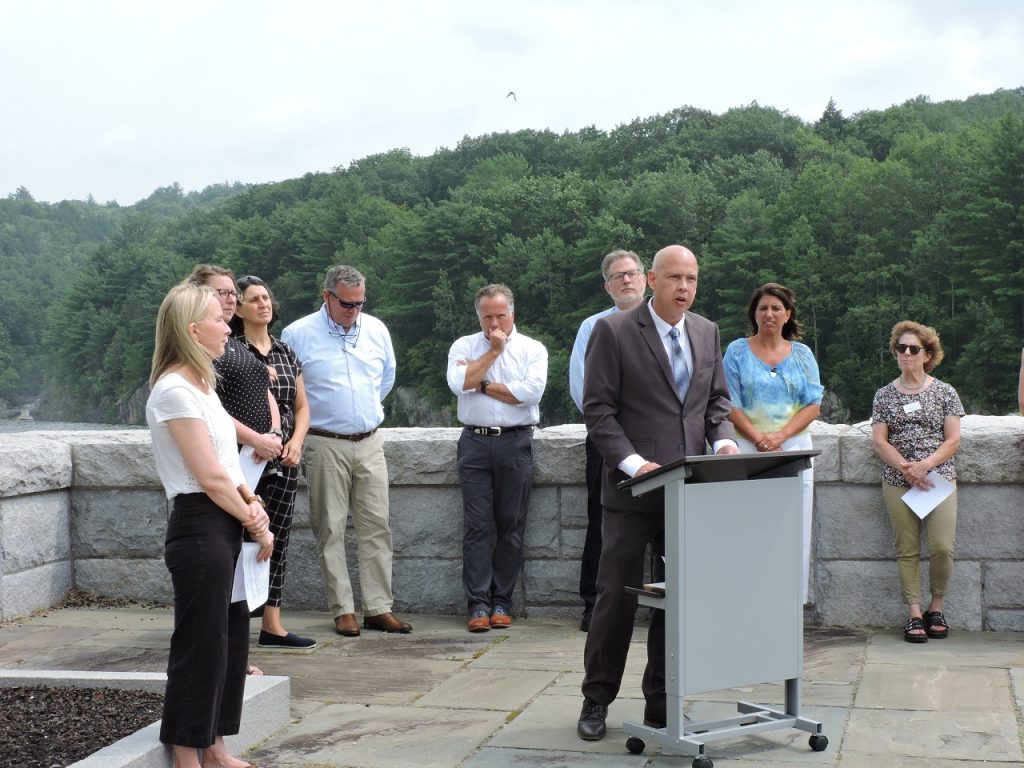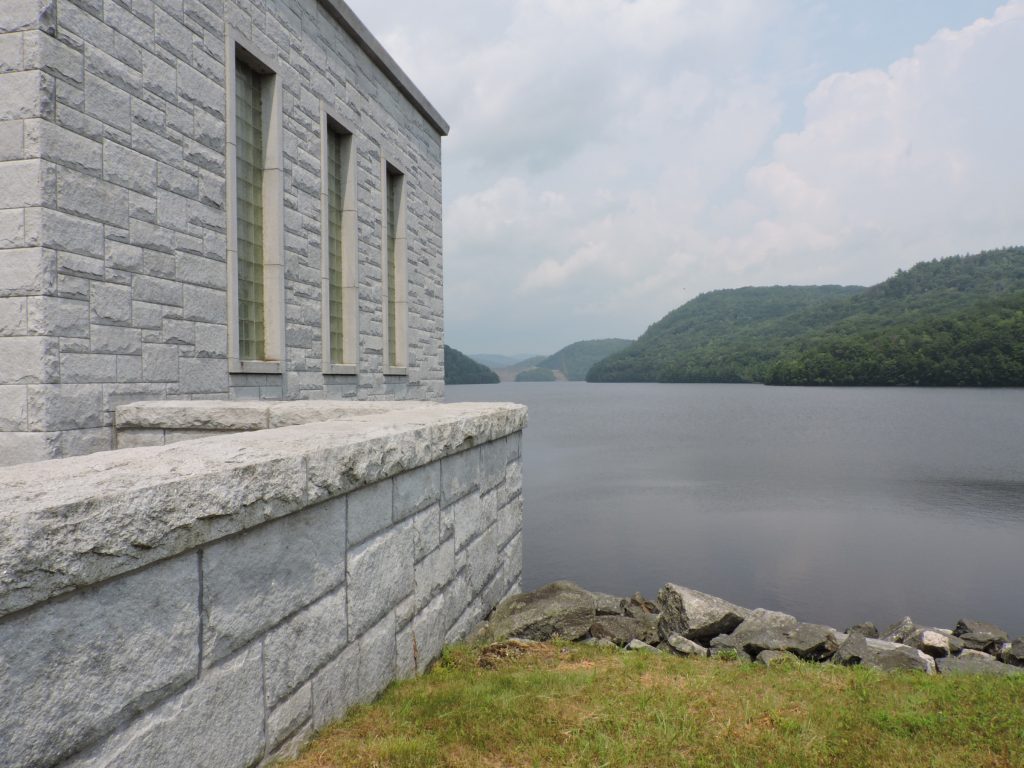Open space in CT and MA to be permanently protected if abandonment permit

COLEBROOK, CT—A groundbreaking win for open space protection in Northwest Connecticut is being celebrated by the Northwest Connecticut Land Conservancy (NCLC) and Save the Sound, who have reached a Memorandum of Understanding with The Metropolitan District (MDC) to negotiate the terms and conditions of a conservation easement on approximately 5,500 acres. The land is located on the watershed tributary to the Colebrook Reservoir/West Branch Reservoir system, including 4,300 acres of open space land surrounding the Colebrook River Reservoir in Connecticut, and an additional approximately 1,200 acres in Massachusetts.
The Memorandum of Understanding and the conservation easement protecting the lands was prompted by MDC’s move earlier this year to seek an abandonment permit for a 10 billion gallon (BG) water storage space in the Colebrook River Reservoir. Open space land surrounding drinking water supplies is currently subject to protections under state law. An abandonment permit would result in the 10 BG no longer being considered a potential drinking water supply by Department of Public Health. Environmental organizations were concerned that such an abandonment, if approved by DPH, could set a precedent that would potentially jeopardize the status of the land surrounding the reservoirs, which is currently open space.
[UPDATE 7/20/23: The Department of Public Health has approved the permit, clearing the way for our agreement to go into effect. Read the agency’s decision here.]
“The permanent protection of these 5,500 acres of natural lands and forests surrounding the Colebrook and West Branch Reservoirs is exceptionally important to the region’s conservation future. The best way to protect our high-quality reservoirs, rivers, and streams is to protect the forested lands around them,” said Catherine Rawson, executive director of NCLC. “Through the vision and partnership of MDC and the state’s leading environmental organizations, if the abandonment permit is granted, these essential lands and waters will be protected for the public benefit forever.”
“Water supply lands are of tremendous value for the present and future generations of Connecticut and Massachusetts residents,” said Roger Reynolds, senior legal director for Save the Sound. “These lands are currently quasi-protected yet vulnerable to development, as their conservation is contingent on use of these reservoirs for water supply. This agreement adds an important layer of protection for human health, wildlife habit, water quality, and recreational access. The best way to protect the purity of future water supply is to permanently conserve the lands necessary to protect them.”
“It is important to note that each of the four Colebrook Reservoir towns—Barkhamsted, Colebrook, New Hartford, and Hartland – have submitted letters of support of the MDC’s abandonment application to DPH. For decades, these towns and their residents have partnered with the MDC and its staff in ensuring that the land surrounding the Colebrook Reservoir is maintained as a protected watershed and available for passive recreation,” stated Scott Jellison, MDC Chief Executive Officer. “We are not abandoning that partnership. Our environmental stewardship of this critical land area has been and will continue to be among the highest priorities. MDC and the watershed towns recognize the 10 billion gallons of future potential emergency drinking water would not be available during a drought and that the best use is for recreational and river benefits. The towns do not support diverting the reservoir for drinking water supply.”

MDC’s rights to 10 BG of water storage space in the Colebrook Reservoir/West Branch Reservoir system come through a contract with the U.S. Army Corps of Engineers. Upon termination of the contract, MDC will no longer have rights to the storage area nor the financial obligations that follow. If an abandonment permit is granted, MDC will continue to hold rights to 6.5 BG of water between the two reservoirs. A permanent conservation easement would ensure that this abandonment permit (if approved by DPH) and any future changes to the status of the remaining water resources in this watershed do not result in changes to the conservation status of the surrounding lands.
Under the terms of the new agreement, NCLC will purchase a conservation easement on 5,500 acres of MDC-owned land for $1 million. MDC will be permitted to continue its existing uses of the property. New public access to the property will be allowed for passive recreation such as hunting, fishing, hiking, and boating, subject to NCLC and DPH approval. Residential, industrial, commercial, and other forms of development will not be allowed. Save the Sound and Rivers Alliance of Connecticut requested and were granted a public comment period on the abandonment permit, given the importance of the decision for both drinking water supply and source protection land conservation.
Save the Sound, NCLC, Rivers Alliance of Connecticut, Farmington River Watershed Association, Connecticut Land Conservation Council, and The Nature Conservancy in Connecticut jointly submitted comments to DPH in support of MDC’s move to give up a portion of its water rights, noting the environmental benefits—particularly the potential for unrestricted water flow downriver, which, especially during low flow conditions, could improve aquatic life, river water quality, and ecological diversity within the downstream reaches of the river. In addition, the conservation easement on the lands will help to maintain “raw drinking water quality” in the remainder of the reservoir’s supply for potential future use. DPH is expected to issue a decision on MDC’s abandonment permit request on or about July 20. [Update: the permit has been approved.]
“Protecting this large forest tract in its current state will forever preserve and protect the water in Colebrook Reservoir as a drinking water source but will also forever be a pristine source of freshwater downstream for the West Branch of the Farmington River,” said Aimee Petras, executive director of the Farmington River Watershed Association. “For over 50 years, the Farmington River has benefited from the augmented cold-water releases provided by the Colebrook Reservoir through Goodwin Dam, often at a flow rate higher than upstream in-flows. These flows, and their reliable high quality, have fostered a recreational fishery that is one of the best in the nation as well as a vibrant paddling community. Today we celebrate that these lands will forever protect what our Farmington River Community has grown to rely upon and will be forever protected for future generations.”
“The Nature Conservancy is thrilled that this new MOU will help protect such a large set of forested lands in the headwaters of the Farmington River,” said Sarah Pellegrino, Land Protection and Strategies Manager for the Connecticut Chapter of The Nature Conservancy. “In protecting these forests we are protecting not only their own rich biodiversity, but also one of the highest quality river systems in the Connecticut River watershed.”
Amy Blaymore Paterson, executive director of the Connecticut Land Conservation Council, said, “On behalf of the Connecticut Land Conservation Council, I commend the Northwest Connecticut Land Conservancy, Save the Sound, and the Metropolitan District Commission for their visionary collaboration in preserving Connecticut’s precious natural resources. This momentous land conservation partnership has the potential to safeguard one of the state’s largest remaining contiguous blocks of forested land, ensuring clean drinking water, purifying our air, protecting wildlife habitat, and helping to mitigate the climate crisis by absorbing and storing greenhouse gases, among many other benefits. Their dedicated efforts are a shining example of how strategic partnerships can create a sustainable and resilient future for Connecticut.”
